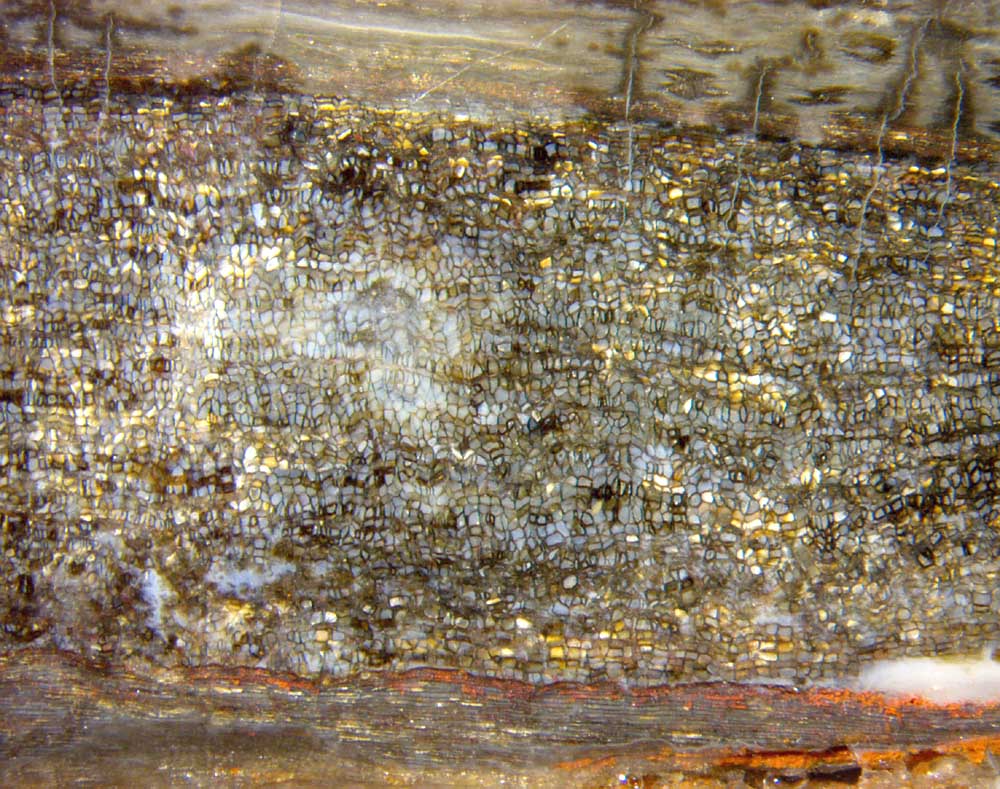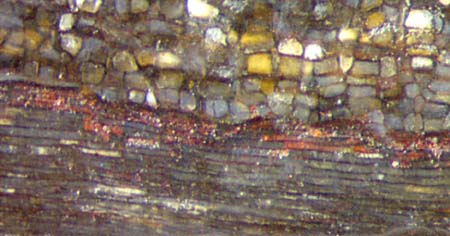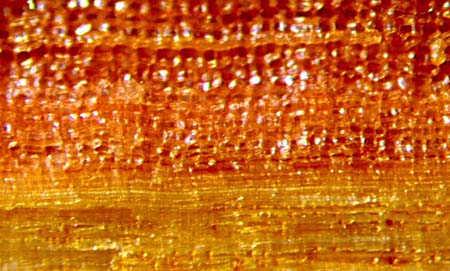Pith in petrified wood from the
Permian Doehlen Basin

The
central pith of palaeozoic coniferous trees had most often been
degraded or decayed before the tree trunk had become thoroughly
silicified
so that trunk fragments with well
preserved pith
are seldom found. The aspect of petrified pith may differ conspicuously
from that of the surrounding wood. This is seen in cross-section in Fossil
Wood News 27
where there is no well-defined boundary between pith and wood but a
transitional region instead. Likewise conspicuous is the aspect of
longitudinal sections as seen here.
Fig.1: Central part of a silicified coniferous tree, pith between wood.
Sample:
W/42.1, Wilmsdorf. Image width 8mm.
In this case there seems to be a definite boundary between the chaotic
pith and the orderly wood with narrow tracheids. This is more
clearly seen in Fig.2.

Fig.2: Permian pith with cells of various sizes bordering on wood
with
tracheids 40Ám across. Detail of Fig.1, width
2mm.
Remarkably, the combination of
central pith and surrounding wood as a main characteristic of tree
trunks has persisted from the gymnosperms of the Carboniferous until
present. Since it is found with Angiosperm trees as well (Fig.3),
one
may wonder whether the usually narrow pith is a relevant structure or a
mere
relic of evolution. No answer is given here.

Fig.3 (left): Raw crack face of cleft Prunus stem,
recent, 12 years old, pith with cell
sizes of about 80Ám bordering on wood with
tracheids 15Ám across. Same
scale as Fig.2, width
2mm.
The polyhedral cells of the recent pith are seen to be preferably
arranged here
in vertical rows in the stem (horizontal in the picture). The white
spots are reflections from the glossy walls of the empty cells.
Other
than the cleft wood in Fig.3, the cut and polished petrified wood in
Fig.1 is perfectly smooth and plane since there are no cells left
hollow.
The variety of cell shape and arrangement in Fig.1 is puzzling. It
is a peculiar combination of randomness and chain-like order.
All cells are filled with bluish
or white chalzedony. A small part of the pith, below in Fig.1 and
enlarged in Fig.2, shows a different pattern
which suggests a stack of block-shaped cells.
As an exception to the rule that the central pith is
insignificant from
a mechanical point of view, the small uncommon Permian conifer Dicranophyllum,
height about 3m, is
mentioned (but not pictured) here. It is thought to consist of
a thin-walled wooden (?) tube filled
with pith, apparently to provide bending strength. It has been found
fossilized as
compressions only so that the cellular structure of its mechanically
relevant pith remains unknown. (There are publications on Dicranophyllum
hallei with erroneous size data.)
H.-J. Weiss 2019
|

|
 31 31 |

 31
31



 31
31